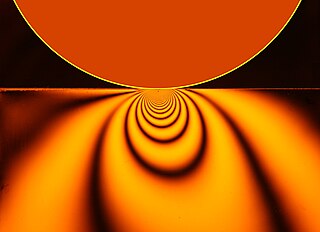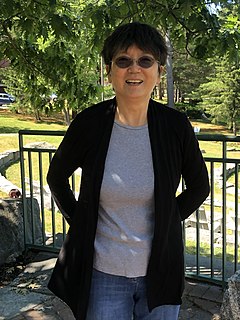Related Research Articles

Friction is the force resisting the relative motion of solid surfaces, fluid layers, and material elements sliding against each other. There are several types of friction:
Tribology is the science and engineering of interacting surfaces in relative motion. It includes the study and application of the principles of friction, lubrication and wear. Tribology is highly interdisciplinary, drawing on many academic fields, including physics, chemistry, materials science, mathematics, biology and engineering. People who work in the field of tribology are referred to as tribologists.

Nanoelectromechanical systems (NEMS) are a class of devices integrating electrical and mechanical functionality on the nanoscale. NEMS form the next logical miniaturization step from so-called microelectromechanical systems, or MEMS devices. NEMS typically integrate transistor-like nanoelectronics with mechanical actuators, pumps, or motors, and may thereby form physical, biological, and chemical sensors. The name derives from typical device dimensions in the nanometer range, leading to low mass, high mechanical resonance frequencies, potentially large quantum mechanical effects such as zero point motion, and a high surface-to-volume ratio useful for surface-based sensing mechanisms. Applications include accelerometers and sensors to detect chemical substances in the air.

An adhesion railway relies on adhesion traction to move the train. Adhesion traction is the friction between the drive wheels and the steel rail. The term "adhesion railway" is used only when it is necessary to distinguish adhesion railways from railways moved by other means, such as by a stationary engine pulling on a cable attached to the cars or by railways that are moved by a pinion meshing with a rack.
Nanotribology is the branch of tribology that studies friction, wear, adhesion and lubrication phenomena at the nanoscale, where atomic interactions and quantum effects are not negligible. The aim of this discipline is characterizing and modifying surfaces for both scientific and technological purposes.

In materials science, asperity, defined as "unevenness of surface, roughness, ruggedness", has implications in physics and seismology. Smooth surfaces, even those polished to a mirror finish, are not truly smooth on a microscopic scale. They are rough, with sharp, rough or rugged projections, termed "asperities". Surface asperities exist across multiple scales, often in a self affine or fractal geometry. The fractal dimension of these structures has been correlated with the contact mechanics exhibited at an interface in terms of friction and contact stiffness.
A mechanician is an engineer or a scientist working in the field of mechanics, or in a related or sub-field: engineering or computational mechanics, applied mechanics, geomechanics, biomechanics, and mechanics of materials. Names other than mechanician have been used occasionally, such as mechaniker and mechanicist.

Contact mechanics is the study of the deformation of solids that touch each other at one or more points. A central distinction in contact mechanics is between stresses acting perpendicular to the contacting bodies' surfaces and frictional stresses acting tangentially between the surfaces. Normal contact mechanics or frictionless contact mechanics focuses on normal stresses caused by applied normal forces and by the adhesion present on surfaces in close contact, even if they are clean and dry. Frictional contact mechanics emphasizes the effect of friction forces.
In rigid-body dynamics, the Painlevé paradox is the paradox that results from inconsistencies between the contact and Coulomb models of friction. It is named for former French prime minister and mathematician Paul Painlevé.

Kenneth Langstreth Johnson FRS FREng was a British engineer, Professor of Engineering at the University of Cambridge from 1977 to 1992 and a Fellow of Jesus College, Cambridge. Most of his research was in the areas of tribology and contact mechanics.
Contact mechanics is the study of the deformation of solids that touch each other at one or more points. This can be divided into compressive and adhesive forces in the direction perpendicular to the interface, and frictional forces in the tangential direction. Frictional contact mechanics is the study of the deformation of bodies in the presence of frictional effects, whereas frictionless contact mechanics assumes the absence of such effects.
The Reynolds Equation is a partial differential equation governing the pressure distribution of thin viscous fluid films in lubrication theory. It should not be confused with Osborne Reynolds' other namesakes, Reynolds number and Reynolds-averaged Navier–Stokes equations. It was first derived by Osborne Reynolds in 1886. The classical Reynolds Equation can be used to describe the pressure distribution in nearly any type of fluid film bearing; a bearing type in which the bounding bodies are fully separated by a thin layer of liquid or gas.

Alper Erturk is a mechanical engineer and the Woodruff Professor in the George W. Woodruff School of Mechanical Engineering at Georgia Institute of Technology.
Extreme tribology refers to tribological situations under extreme operating conditions which can be related to high loads and/or temperatures, or severe environments. Also, they may be related to high transitory contact conditions, or to situations with near-impossible monitoring and maintenance opportunities. In general, extreme conditions can typically be categorized as involving abnormally high or excessive exposure to e.g. cold, heat, pressure, vacuum, voltage, corrosive chemicals, vibration, or dust. The extreme conditions should include any device or system requiring a lubricant operating under any of the following conditions:

Jean-François Molinari is a French-Swiss engineer and scientist specialised in the numerical modeling of the mechanics of materials and structures. He is a full professor and the director of the Computational Solid Mechanics Laboratory at the École Polytechnique Fédérale de Lausanne (EPFL).

Robert William Carpick is a Canadian mechanical engineer. He is currently director of diversity, equity, and inclusion and John Henry Towne Professor in the Department of Mechanical Engineering and Applied Mechanics at the University of Pennsylvania. He is best known for his work in tribology, particularly nanotribology.
Judith A. Harrison is an American physical chemist and tribologist who is known for pioneering numerical methods that incorporate chemical reactions into modeling studies. She is a professor in the Department of Chemistry at the United States Naval Academy in Annapolis, Maryland.

Nikolai Pavlovich Petrov was a Russian army professor of mechanics and engineering who is considered one of the founders of tribology or the study of friction and lubrication. He is best known for what is known as Petrov's Law of friction.
Solid bodies in contact that undergo shear relative motion (friction) radiate energy. Part of this energy is radiated directly into the surrounding fluid media, and another part radiates throughout the solid bides and the connecting boundary conditions. The coupling of structural vibration and acoustic radiation takes is rooted in the mechanism of atomic oscillations, by which kinetic energy is translated to thermal energy.

Qian Jane Wang is an American professor of mechanical engineering and the Executive Director for the Center for Surface Engineering and Tribology at Northwestern University. She is a tribologist whose research includes work on contact mechanics, lubrication, micromechanics, and solid-state batteries.
References
- ↑ Adams, G. G. (1995). "Self-excited oscillations of two elastic half-spaces sliding with a constant coefficient of friction". Journal of Applied Mechanics. 62 (4): 867–872. Bibcode:1995JAM....62..867A. doi:10.1115/1.2896013.
- ↑ George G. Adams on Google Scholar Citation
- ↑ Choros, J.; Adams, G.G. (1979). "A steadily moving load on an elastic beam resting on a tensionless Winkler foundation". Journal of Applied Mechanics. 46 (1): 175–180. Bibcode:1979JAM....46..175C. doi:10.1115/1.3424492.
- ↑ Majidi, C.; Adams G. G. (2009). "A simplified formulation of adhesion problems with elastic plates". Proceedings of the Royal Society A. 465 (2107): 2217–2230. Bibcode:2009RSPSA.465.2217M. doi:10.1098/rspa.2009.0060. S2CID 122601465.
- ↑ Majumder, S., McGruer, N.E., Adams, G.G., Zavracky, P.M., Morrison, R.H., & Krim J. (2001). "Study of contacts in an electrostatically actuated microswitch". Sensors and Actuators. 93: 19–26. CiteSeerX 10.1.1.557.3016 . doi:10.1016/S0924-4247(01)00627-6. S2CID 46230996.
{{cite journal}}: CS1 maint: multiple names: authors list (link) - ↑ Adams, A; Nosonovsky, M. (2000). "Contact Modeling — Forces". Tribology International. 33 (5–6): 441–442. doi:10.1016/S0301-679X(00)00063-3.
- ↑ George G. Adams faculty website
- ↑ George G. Adams on Mathematics Genealogy Project